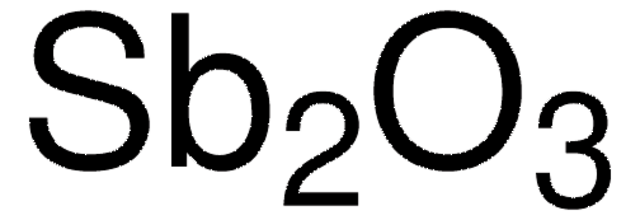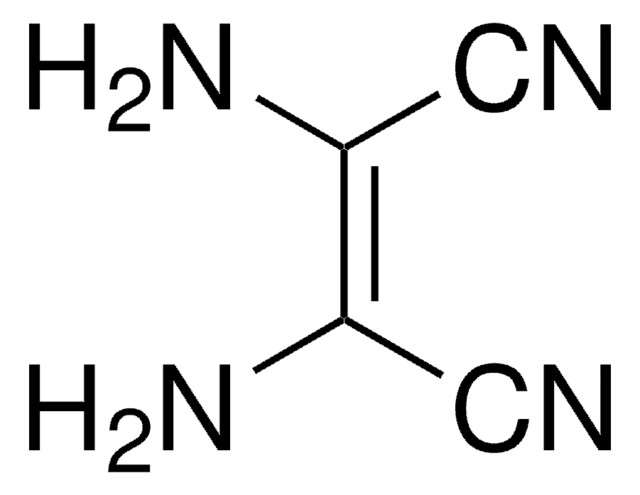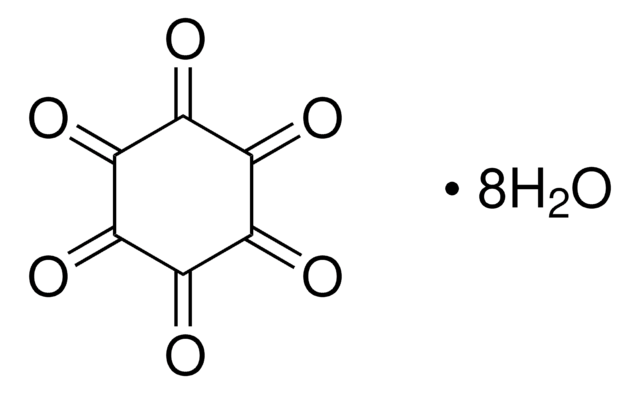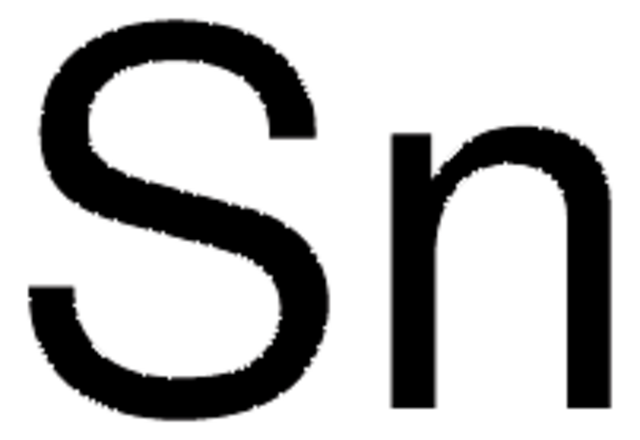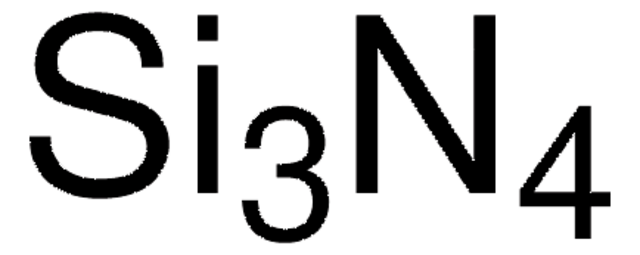230898
Antimony(III) oxide
powder, 5 μm, ReagentPlus®, 99%
Sinónimos:
Diantimony trioxide
Iniciar sesiónpara Ver la Fijación de precios por contrato y de la organización
About This Item
Fórmula lineal:
Sb2O3
Número de CAS:
Peso molecular:
291.52
EC Number:
MDL number:
UNSPSC Code:
12352303
eCl@ss:
38080202
PubChem Substance ID:
NACRES:
NA.23
Productos recomendados
Quality Level
product line
ReagentPlus®
assay
99%
form
powder
particle size
5 μm
bp
1550 °C (lit.)
mp
655 °C (lit.)
SMILES string
O=[Sb]O[Sb]=O
InChI
1S/3O.2Sb
InChI key
ADCOVFLJGNWWNZ-UHFFFAOYSA-N
¿Está buscando productos similares? Visita Guía de comparación de productos
Categorías relacionadas
Application
- Thermal Decomposition and Carbothermal Reduction: Examines the recycling and purification processes of Antimony(III) oxide from metal oxides, valuable for those interested in sustainable metallurgy (Karlsson et al., 2018).
- Oxidation of Antimony(III) in Soil by Manganese(IV) Oxide: Studies the interaction between manganese oxide and antimony(III) oxide in soils, providing insights into environmental chemistry and soil remediation (Fu et al., 2018).
- Adsorption of Antimony(V) onto Mn(II)-Enriched Surfaces: Focuses on how manganese oxide interacts with antimony(V), relevant for those studying adsorption processes and water treatment technologies (Liu et al., 2015).
- Kinetic Modeling of Antimony(III) Oxidation and Sorption in Soils: Provides a kinetic model of antimony(III) interactions with environmental matrices, useful for environmental scientists and chemists involved in pollution control (Cai et al., 2016).
Legal Information
ReagentPlus is a registered trademark of Merck KGaA, Darmstadt, Germany
signalword
Warning
hcodes
Hazard Classifications
Carc. 2
Storage Class
13 - Non Combustible Solids
wgk_germany
WGK 1
flash_point_f
Not applicable
flash_point_c
Not applicable
ppe
Eyeshields, Gloves, type P3 (EN 143) respirator cartridges
Elija entre una de las versiones más recientes:
¿Ya tiene este producto?
Encuentre la documentación para los productos que ha comprado recientemente en la Biblioteca de documentos.
Los clientes también vieron
P M Hext et al.
Journal of applied toxicology : JAT, 19(3), 205-209 (1999-06-11)
Diets containing antimony trioxide were fed to male and female Wistar rats of the Alpk:APSD strain over 90 days. Dose levels were 0 (control), 1000, 5000 and 20,000 ppm (equivalent to mean daily doses of 84, 421 and 1686 mg
Delia Cavallo et al.
Environmental and molecular mutagenesis, 40(3), 184-189 (2002-10-02)
The growing use of antimony (Sb) compounds in industry and the consequent increase in the number of exposed workers make it important to carry out a health risk assessment. The main goal of this study was to assess the genotoxicity
Ivo Iavicoli et al.
Journal of trace elements in medicine and biology : organ of the Society for Minerals and Trace Elements (GMS), 16(1), 33-39 (2002-03-07)
Antimony trioxide (Sb2O3) is used as a flame retardant in the textile industry. We carried out a study in a factory for the evaluation of antimony (Sb) occupational exposure and urinary levels in workers exposed to Sb2O3. Urinary levels and
R O Jenkins et al.
Human & experimental toxicology, 17(4), 231-238 (1998-06-09)
1. The aerobic filamentous fungus S. brevicaulis IMI 17297 methylated antimony from Sb2O3 substrate, with the formation of gaseous trimethylantimony (TMA). No evidence was found for the generation of other gaseous antimony compounds by this organism. 2. Biovolatilization of inorganic
Wook Jo et al.
Acta crystallographica. Section A, Foundations of crystallography, 63(Pt 3), 229-233 (2007-04-17)
The composition planes of the inversion boundary induced by the addition of Sb2O3 to ZnO ceramics were analyzed crystallographically by the application of electron back-scattered diffraction (EBSD) analysis and stereographic projection techniques. The inversion boundary was determined to consist of
Nuestro equipo de científicos tiene experiencia en todas las áreas de investigación: Ciencias de la vida, Ciencia de los materiales, Síntesis química, Cromatografía, Analítica y muchas otras.
Póngase en contacto con el Servicio técnico